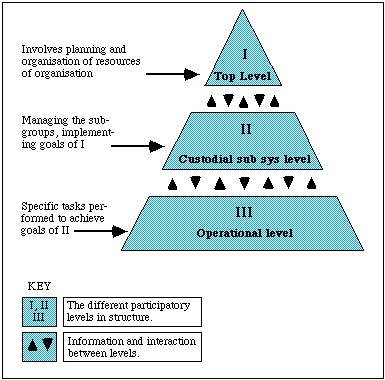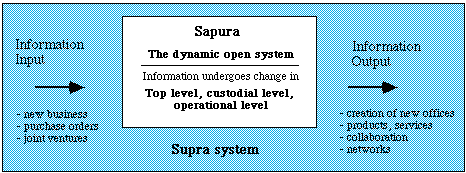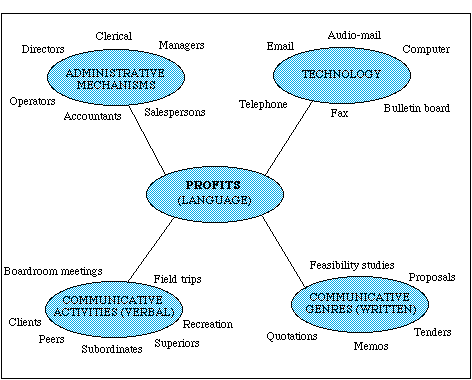Participatory mechanisms in Sapura Pty Ltd

Prerequisites for the teaching of English for Special Purposes (ESP) are an understanding of the culture and the identification of target texts (spoken and written) within the community in which the learner wishes to participate. Only when there is awareness and first hand experience of both the community and community specific texts can organised learning of new members take place. This investigation examines a Malaysian business organisation according to Swales' (1990) notion of a "discourse community". It is an empirical investigation of business practices in the business sector in Malaysia. The growth centre of world economy is now in the Asia Pacific region, and this, with the impact of technology, has caused many changes in the business practices in this area. What are these changes? What are the expectations and aspirations and ethos of successful local companies? The insights gleaned from such an investigation will have important pedagogical implications for the training of professionals. It is with these questions in mind that Sapura Sdn Bhd, a very successful national company in the manufacturing sector, was approached to conduct this research.
The rapid development of information technology, the widespread use of electronic media and the current interest in the development of knowledge and service industries have brought about a new need: competence in English, the language of trade and commerce. Given these changes in the social and economic environment, many Malaysians are now feeling the pressure of being forced to communicate effectively in their second language in the business sector. Coming from a medium of instruction in Malay, many new members of the industry are at a disadvantage, not only because of a lack of general proficiency in English, but more importantly because of ignorance of the variety of English used in business discourse.
This situation is further compounded by Malaysia moving from agriculture based to manufacture-based industries. The change in focus has brought about a need to compete and communicate with the rest of the world, especially with the developed countries who have been the leaders for manufactured goods. Following Green's (1993, p.4) argument that "English language and literacy courses stand as the significant gatekeepers for regulation, membership and access to dominant discourses and traditions, relations of knowledge, power and authority", I suggest that Malaysia's economic interests may be jeopardised through communicative inefficiency in its negotiations with the rest of the world. In order to network with the rest of the world and to take advantage of new office technologies, Malaysians in the business sector must become proficient in the English used in business communities. English has become an agent of social process and change for Malaysians.
Schools and other educational agencies are being called upon to play a more active and appropriate role in preparing young people for entering the post-industrial work world and to help strengthen the hand of the national economy. Like a football coach, the task of the ESP teacher is to know not only the strengths and weakness of the away team but also to be extremely knowledgeable about the rules and regulations of the game so as to well equip the home team for the sport. In the ESP context, effective teaching of skills means effective operation of mechanisms within the industry. The ESP teacher must first understand the society and the mechanisms that operate in that society before s/he can begin to equip new members with effective skills.
The mechanism in this communication chain or network, is linguistic and can be described by a researcher. The knowledge gained would make newcomers and ESP teachers aware of the ways in which communities actively participate in the building of social reality in language, because the different ways of working are encoded in the linguistic patterns used by that social group. The individual is seen as a social being achieving a sense of membership into the ways of working of the community, especially where such ways are linguistic. The individual is initiated through guidance and experimentation with the models of other experts in the community.
In short then, this approach holds the view that if one is to see a real change in ESP education for a particular business organisation, one needs an understanding of the business discourse community as a whole before one can focus on the individual member's communication needs within the setting.
Sapura is an extremely large organisation, and it is beyond the scope of this paper to study the whole organisation complete with its 36 subsidiaries. The inquiry therefore will first investigate one strand of its subsidiary companies, the telecommunications block, in greater detail. The companies chosen were Apple Uniphone Sdn Bhd, Sapura Advanced Systems Sdn Bhd and Micro Express Sdn Bhd.
The interview procedure was a structured interview lasting 35 minutes each with 10 managers. A structured interview format was chosen to ensure that there was no miscomprehension of questions and information; only one interviewer, myself, was used for all the interviews to ensure consistency and reliability. The interviewees in this study were basically people in companies who are in the forefront of technological change. Only managers with experience in their jobs were interviewed as this was felt to be important for obtaining accurate and informed responses. These managers were chosen because they are successful in their field and it was thought that their responses would provide insights into how successful managers respond to new changes in the industry, while at the same time, because of their position, they would be able to give informed responses about their organisation.

At the top level, the system consists of the executive chairperson, the executive vice-chairman and the group managing director, who concern themselves with the strategic view of the organisation. This strategic view involves planning for the future of the enterprise and organising its resources. The main concerns of this layer are broad long-term, unstructured and externally oriented.
Below the strategic level is the tactical layer (or the custodial sub system) which concerns itself with managing the specific sub groups of the company. These middle managers organise the tasks of the enterprise as efficiently as possible. They convert the broad goals that are defined at the strategic level into tactics that can be implemented to achieve these goals. The viewpoint and information needs of this layer are intermediate, between those of the strategic level above and the operational level below.
The next level, the operational level of the organisation has specific tasks that need to be performed to achieve the goals of the company. These tasks are relatively narrow, short-term, structured and internally oriented. The information needs at this level are stable and predictable provided that the strategic goals of the enterprise do not change. All the various levels are thus participatory mechanisms that interact between the levels and amongst each level for Sapura's quest for survival.

Thus, Sapura is a dynamic open system or network that exists, interacts and becomes dependent for survival on participation and information exchange not only within the system but also with the Supra system or the environment.
The interview with the managers disclosed that the purposes are common knowledge within the community and documents are routinely used by members in their transactions. The bulk of written documents produced was essentially documents that already have a definite, repeatable format. The trend is that more and more documents are produced electronically and stored in disks instead of filing cabinets. According to my study, as well as other studies in this region (Chan, 1993), word processing/personal computers and electronic mail are currently the most widely used and most popular systems. Everyone in these three organisations is hooked up with email and it has become a very important and popular form of communication both within and outside the organisation. Email, though used extensively, did not have a specific format that everyone subscribed to and therefore became a concern for further study.

In face-to-face conversation, for example, the new speaker relies on paralinguistic cues like pauses, eye contact etc for the cue to speak, but such cues are not available in on-going computer conversation. One needs to rely on a new set of cues that seem to play the same role as paralinguistic features in actual face-to-face conversations.
To simulate these paralinguistic cues and features and create a sense of personal involvement, interactants use graphical representation, for example, exclamation mark, bold print, elongated vowel sounds, stress through underlining, and so on. These interactants use discourse features from both oral and written discourse. They change "voice" and indicate this range of personal involvement through pronoun use, choice of diction and graphical marks (Le Vasan 1994). Computer conversation displays both the transience of speech and permanence of writing. The retention of the message can be for the life of one screen full only or for posterity.
Contrary to popular opinion this of course indicates that computer conversation is personal, interactive and very warm. It also exhibits characteristic forms of written discourse because interactants decide on the "voice" ahead of time - from solidarity to unscrupulous business person. This is also seen in the way the language moves along the oral-written continuum. The sender's role very much paces the language and chosen voice which to a certain extent also shape the voice of the response. Interactants become very adept at creating meaning in this system and communication is certainly not as passive as one has been led to believe.
The integration of office technologies, computers, email, faxes, voice machines, implies the need of an English Language communication skills program that enables one to function and communicate within the limitations and advantages of these office technologies. Such a program would enable new members to learn to operate in the target language by learning how expert members of the community already function and use the language for this specific social need in the community. It also implies that ESP teachers must become community sensitive analysts of target texts because the language learners in this community are the real content experts while the ESP teacher is only the informed facilitator of how language functions in these community specific texts, in community-specific contexts. Teachers thus need to work with target texts themselves to ensure that there is a good match between learner needs and community demands.
The company Sapura recognises the importance of management having strong communication skills in English. Many if not all upper and middle management are Malaysians who have graduated from foreign universities, implying that local graduates do not yet have the command of English required by the company. Greater proficiency in the English language would enable graduates from local universities to be more marketable in the private sector, and more importantly it would help them function effectively and adjust quickly to the communication needs within the organisation.
In the teaching of written discourse, it is possible to replicate some of the activities of the business community because writing is a time delayed activity and therefore can be done in the classroom, provided community values (already identified above) are in place. While this is true for most of the genres in written business discourse, it does not hold true for email which is not a time delayed activity most of the time. The fleeting yet semi-permanent nature of the email makes it an enigma that warrants further research.
These findings indicate that more research is needed into email but it is beyond the scope of this paper to provide that detail. Such research is currently being carried out as a doctoral dissertation by the writer.
Draft, R. L. (1989). Organization theory and design. USA: West Publishing Company.
Green, B. (1993). The insistence of the letter: Literacy studies and curriculum theorising. London: Palmer.
Halliday, M. A. K. (1978). Language as a social semiotic. London: Edward Arnold.
Halliday, M. A. K. (1985). Spoken and written language. Geelong: Deakin University Press and republished in 1989 by Oxford University Press, London.
Hodge & Kress. (1988). Social semiotics. Cambridge, UK: Polity Press.
Halliday, M. A. K. & Hasan, Ruqaiya. (1985). Language, context and text: A social-semiotic perspective. Geelong: Deakin University Press and republished in 1989 by Oxford University Press, London.
Le Vasan, M. (1994). A Semiotic analysis of one email transaction in business. Paper presented at the International conference on "Professional Communication in the work place." Hong Kong City Polytechnic, March 28-30.
Swales, J. (1990). Genre analysis: English in academic and research setting. USA: Cambridge University Press.
Malaysia: The way forward (1991). Working paper of the Prime Minister of Malaysia.
Torrington, D. & Hall, L. (1992). Personnel management. New Straits Times, April 27th.
| Author: Mani Le Vasan is a lecturer with the University of Malaya, Malaysia. She teaches English as a second language and English for specific purposes at the Language Centre of University Malaya. She is currently doing her PhD in the area of business discourse. She spent ten months on a sabbatical attachment with the School of Education at Murdoch University where she was introduced to the field social semiotics. Her interests include ESL, ESP and educational technology.
Please cite as: Le Vasan, M. (1994). Teaching English for special purposes: A case study of a Malaysian business organisation. Issues In Educational Research, 4(1), 35-47. http://www.iier.org.au/iier4/levasan.html |
© 1994 Issues in Educational Research
Last revision: 5 Nov 2013. This URL: http://www.iier.org.au/iier4/levasan.html
Prevoius URL: http://education.curtin.edu.au/iier/iier4/levasan.html
Previous URL from 5 July 1997 to 7 Aug 2001: http://cleo.murdoch.edu.edu.au/gen/iier/iier4/941p35.htm
HTML: Clare McBeath [c.mcbeath@bigpond.com] and Roger Atkinson [rjatkinson@bigpond.com]